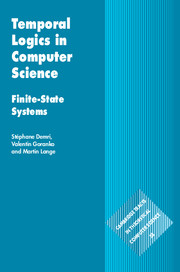11 - Computational Complexity
from PART III - PROPERTIES
Published online by Cambridge University Press: 13 October 2016
Summary
This chapter is devoted to the study of the computational complexity of the standard decision problems – satisfiability, validity and model checking – for temporal logics that have been introduced earlier.
Complexity theory is the classification of problems according to the resources needed to solve (or define) them, not just the resources needed to run a particular algorithm for a given problem. This classification leads to a hierarchy of complexity classes, the important ones have been recalled in Section 2.2.2. Our general aim is, of course, to pinpoint the exact location of a given decision problem for any given temporal logic within this hierarchy. The purpose of this chapter, though, is to focus on lower bounds on these positions.
A decision problem, like the satisfiability problem for LTL, for instance, is classified in a complexity-theoretic sense when matching lower and upper bounds have been found. Upper bounds are often given by the analysis of the resource consumption of a particular algorithm for that problem. Part IVof this book presents different methodologies that can be used to solve these problems for temporal logics. Tight upper bounds on their complexities will be established there. The developments in this chapter underline the notion of optimal complexity used in previous chapters: that no algorithm with considerably less resource consumption can be found for the underlying problem (unless such algorithms could be found for an entire class of problems).
The concept of lower bound is easy to grasp when the complexity hierarchy is not seen as a system measuring absolute but relative values; the complexity of a decision problem is measured by relating it to the complexity of other decision problems. A lower bound of a complexity class C is then simply to be understood as ‘this problem is (provably) as difficult as all problems in the class C’. Difficulty is, of course, measured in a formal way, meaning that one would be able to find better algorithms for all problems in class C if one could find a better algorithm for that particular problem. This decision problem is then said to be C-hard.
- Type
- Chapter
- Information
- Temporal Logics in Computer ScienceFinite-State Systems, pp. 419 - 464Publisher: Cambridge University PressPrint publication year: 2016

